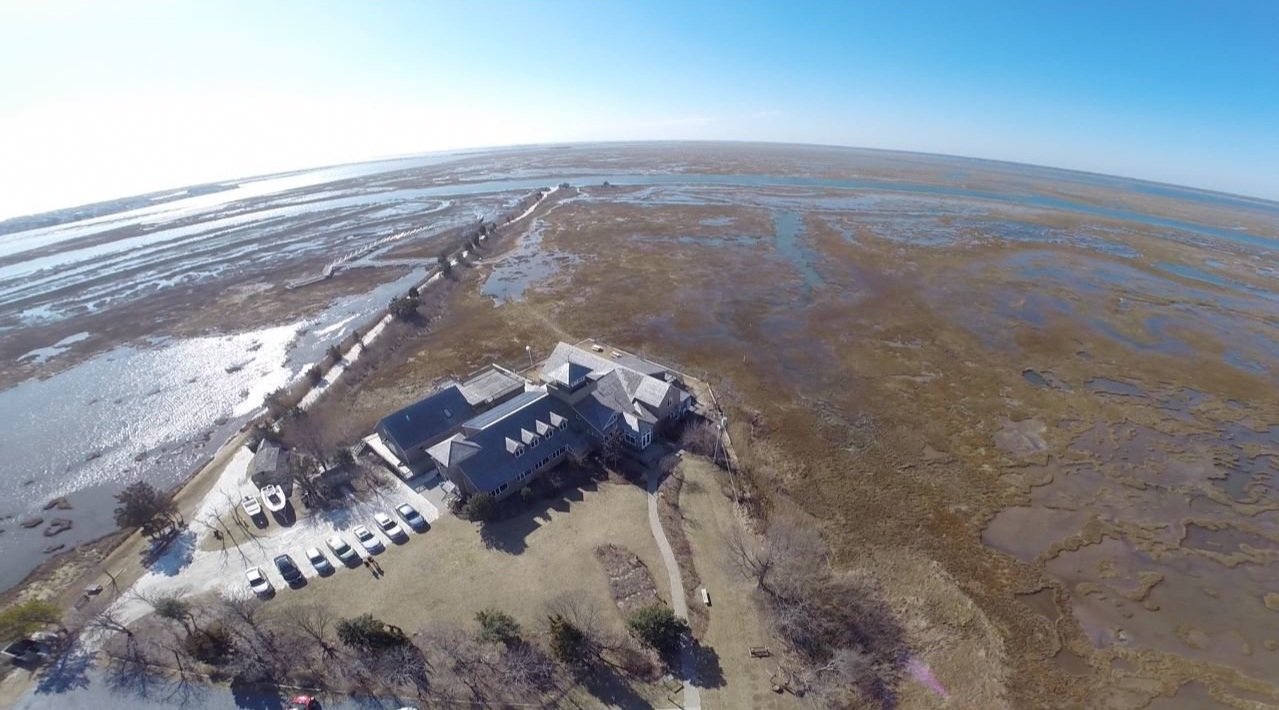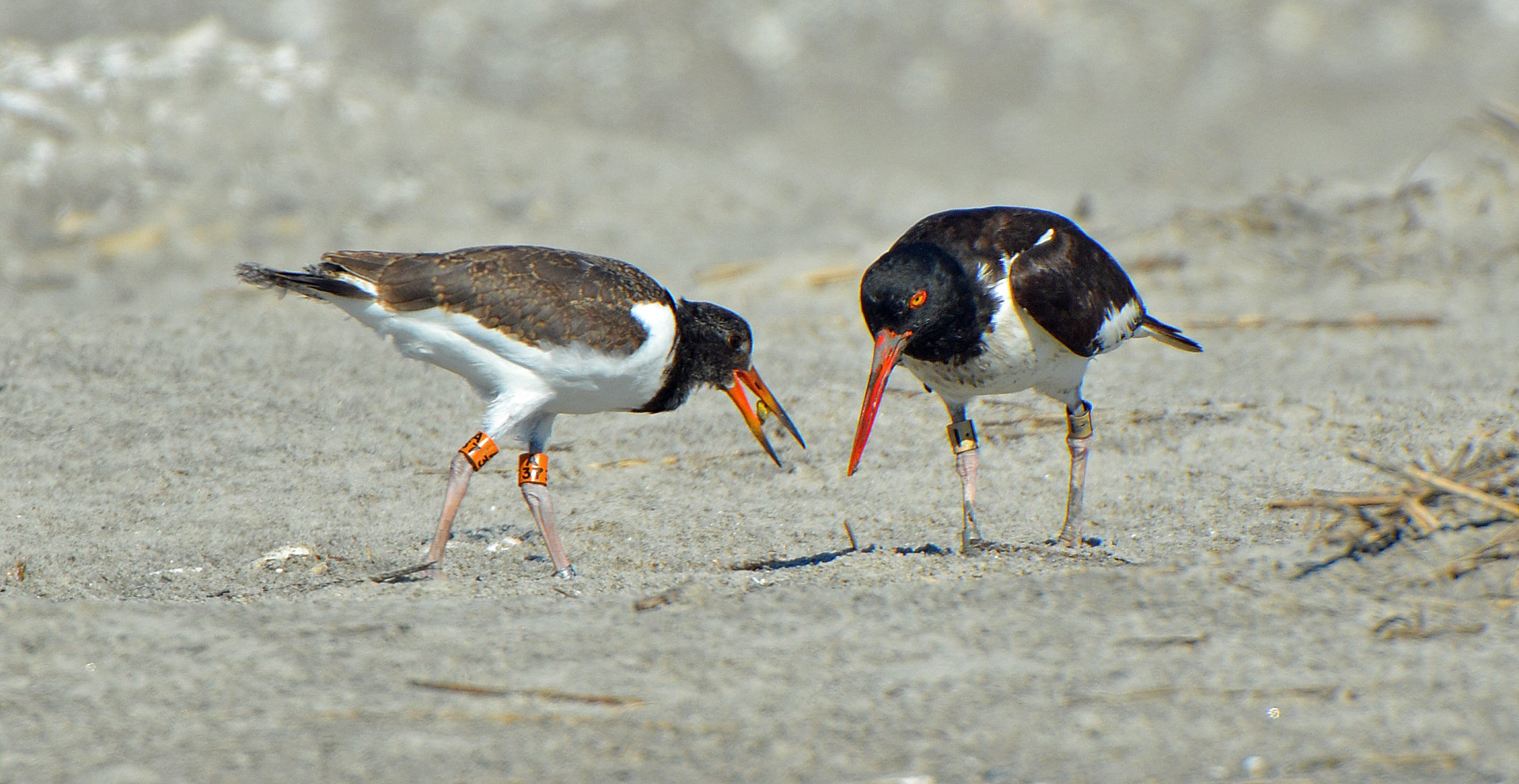Marsh Madness: Wetlands Institute Studying Effects of Rising Sea Level
Increased flooding of the salt marsh as seen from above The Wetlands Institute.
If you have lived near the coast or have visited for many years, you have probably noticed the changes in water levels in our marshes. Lots of people have told me that it used to be a really big deal when the meadows were flooded because it didn’t happen very often. Times have changed. Now, the meadows flood several times every month – even on sunny, calm days. What causes this and what does it mean for our marshes and the wildlife that depend on them? I get asked this a lot, so I thought it would be a good topic to cover.
Regardless of the cause, the sea level in our area is rising. For the past 100 years or so, this is something that scientists directly measure through local tide gauges that record how high the water level rises and falls each day. More recently, satellite technology is also being used. We are fortunate to have several gauges in the area that have relatively long records so that we can see how the sea level has changed. Sea-level measurements taken in both Atlantic City and Cape May show that it is rising at a rate of about 4 millimeters (0.16 inches) per year. This doesn’t seem like much perhaps, but from 1911 to 2016, that is a change of more than 1.3 feet, with more than 6 inches of that rise occurring after 1980. Simply put, the water is rising higher each year and we see it now more dramatically because it’s flooding the marshes and covering over the grasses making it visually obvious. Perhaps you’ve noticed that floating docks are rising higher, too. It’s also bringing tides higher up on our beaches and increasing erosion rates. It’s even causing flooding on some of the area streets. In many ways, it doesn’t matter why it is happening; the key thing is that it is happening.
Scientists at The Wetlands Institute have been concerned about what the rising sea level means to area marshes and beaches. Understanding how local area marshes are adjusting and whether there are effects to wildlife that depend on them is the focus of a new research program at The Wetlands Institute. Thanks to funding from The Davenport Family Foundation and the Leff Family Foundation, The Wetlands Institute has launched a Coastal Sustainability and Wetland Health Research Program.
Over the past year, we have established several marsh monitoring stations that allow for precision measurement of the marsh surface elevation. Marsh grasses grow well over a very narrow range of water depth, so changes in the depth of flooding are important. During times of slowly rising sea levels, many marshes can do quite well and “keep up” with rising water levels. They do this by raising the elevation of the marsh by building dense root structures and trapping storm-transported mud and sand. In some areas, marshes may be able to build up their elevation at similar rates as the sea level is rising. However, if the sea level rises too fast or the marsh is otherwise stressed, marsh plant growth slows and marshes can begin to fall behind and ultimately drown. If this happens, the marsh might shift to mudflats and even open-water areas.
Our ability to precisely measure marsh elevation is allowing us to better understand the condition and response of local marshes. Coupled with monitoring the physical surface of the marsh, scientists are also directly measuring water levels in the marsh through a network of water-level sensors. Monitoring programs also include water chemistry and how well the marsh grasses are growing.
Information about how wildlife is using these marshes and how increased flooding is affecting them is another crucial aspect of the research. The health of coastal bird and diamondback terrapin populations are tightly linked to the condition of coastal marsh systems. Changes in the number of animals in the marsh, how they are using the marsh, and breeding success can indicate changes within the saltmarsh. Several species of birds nest just above the marsh surface, and nest loss due to flooding has become a new reality for them. Are these birds moving to new areas, changing their nesting practices, or just being less successful? Birds of special interest include American Oystercatchers that nest on area beaches as well as in the marsh. Scientists have been banding individual birds for the past several years so that individual birds can be tracked and monitored. Clapper rails, willet, laughing gulls and seaside sparrows are also species of interest and the subject of various monitoring programs. How is repetitive marsh flooding affecting diamondback terrapins? They seek nesting areas that are above the high-tide line, yet their nests are also becoming more frequently flooded, too. Is the flooding affecting hatchling terrapins that spend their early years in the marshes instead of the tidal creeks?
There is a lot to learn, so as stewards of the wetlands our staff is working to learn as much as we can. It will be important to have several years of information so that weather patterns, storms and other fluctuations can be better reflected in the information. The Wetlands Institute is fortunate to have decades of information that has been collected over the years, and this work continues to build these important data sets. The Wetlands Institute scientists have been working on a host of projects over the past few years that also contribute to our knowledge. We have been working on projects on our beaches to enhance the nesting habitat for beach-nesting birds to help offset increased flooding of their nests. Our teams have been monitoring the effectiveness of habitat creation in the marsh at Ring Island to provide nesting areas for birds being flooded off beaches and other areas of the marsh. This area was built using sandy dredge material. We are also working on monitoring teams assessing the effectiveness of marsh-restoration techniques using muddy dredge material to try to help build marsh elevation to help marshes combat drowning.
We work hard to translate the information we are collecting and provide guidance to decision-makers about the condition of our marshes and how they can continue to play an important role in coastal sustainability and storm protections for our community. These are very complex systems, and great care and diligence must be taken to make sure that first and foremost our efforts do no harm. We are working to make sure these marshes are here for generations to come.
WINTER AT THE WETLANDS INSTITUTE
Activities on the marsh are scheduled every Saturday and Sunday from 9:30am to 4:30pm. Visit wetlandsinstitute.org/events to see what’s happening at The Wetlands Institute.
Winter Lecture Series:
The winter lecture series consists of weekly daytime (Lunch and Learn) or monthly evening (Covered Dish Dinner) presentations occurring on-site at The Wetlands Institute. Throughout the series, guest presenters from around the state share presentations and/or programs on a variety of scientific and cultural topics. Visit wetlandsinstitute.org/winter-lecture-series for schedule and details.
Holiday Gift Ideas:
Looking for a meaningful gift that also supports wetland and coastal ecosystem conservation? Here are some great ideas:
The Wetlands Institute’s Tidepool Shop is stocked with unique gifts and nature books for all ages.
Give the gift of flexibility with a gift card that can be redeemed for Wetlands Institute merchandise, event tickets, and more!
When you give the gift of membership to The Wetlands Institute, you not only support our mission but you also allow the institute to advance its impactful research, conservation and education work.
Adoptions make great gifts! The symbolic Terrapin, Horseshoe Crab, and American Oystercatcher adoptions are a great way to directly impact conservation of their favorite wetlands species!







